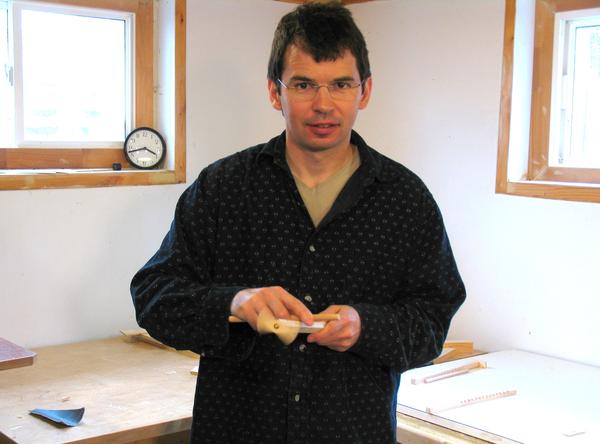 In German, I knew it as the "Hui spiel" (Hui game), and
I was able to find it online under that name as well.
In English, it's usually called a "hooey stick", but also "magic propeller stick", "geehaw stick" or "geehaw whimmy diddle".
In German, I knew it as the "Hui spiel" (Hui game), and
I was able to find it online under that name as well.
In English, it's usually called a "hooey stick", but also "magic propeller stick", "geehaw stick" or "geehaw whimmy diddle".
 In German, I knew it as the "Hui spiel" (Hui game), and
I was able to find it online under that name as well.
In English, it's usually called a "hooey stick", but also "magic propeller stick", "geehaw stick" or "geehaw whimmy diddle".
In German, I knew it as the "Hui spiel" (Hui game), and
I was able to find it online under that name as well.
In English, it's usually called a "hooey stick", but also "magic propeller stick", "geehaw stick" or "geehaw whimmy diddle".
The game is a rather simple sort of "magic trick". You rub the dowel on the stick with the propeller, and the propeller turns. And when you say "Hui" (pronounced like hooee, but with an emphasis on the e), the propeller reverses direction.
Then you let other people try it, but when they rub the dowel across the stick nothing happens!
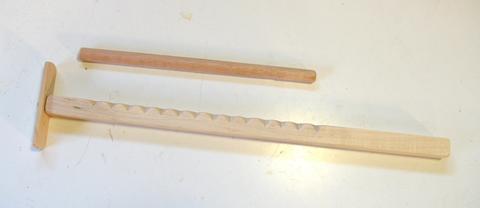 The hui consists of just a stick with notches carved into it and a propeller on the end,
plus a dowel to rub across those notches. The trick is in how you rub the dowel
along the stick, and to do it in such a way that people can't tell what you are doing.
The hui consists of just a stick with notches carved into it and a propeller on the end,
plus a dowel to rub across those notches. The trick is in how you rub the dowel
along the stick, and to do it in such a way that people can't tell what you are doing.
I'll explain the trick at the end of the article.
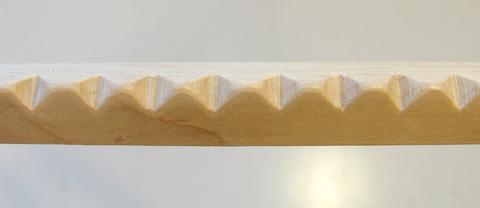 The most important feature of the hui is the series of notches.
The stick is about 14x14 millimeters and 30 centimeters long.
The notches are about 6 mm deep, spaced about 13 mm apart.
These dimensions don't need to be exact, but I found those proportions to be the nicest to use.
I actually spaced the notches 1/2" apart (12.7 mm), which made them easier to
mark the spacing using the inch scale on my tape measure.
The most important feature of the hui is the series of notches.
The stick is about 14x14 millimeters and 30 centimeters long.
The notches are about 6 mm deep, spaced about 13 mm apart.
These dimensions don't need to be exact, but I found those proportions to be the nicest to use.
I actually spaced the notches 1/2" apart (12.7 mm), which made them easier to
mark the spacing using the inch scale on my tape measure.
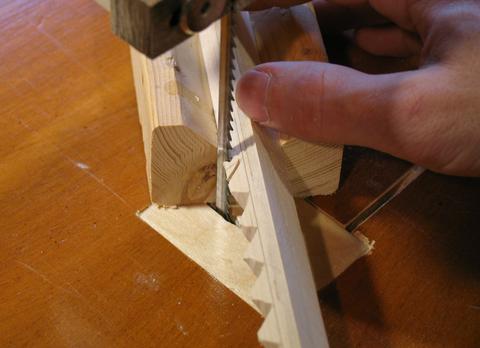 The easiest way to cut out the notches is to place the stick on a V-block and cut them
out with a bandsaw. If you don't have a bandsaw, you can carve them out with a knife
or file them out. But I broke my wrist recently,
so I'll stick to using power tools for the time being.
The easiest way to cut out the notches is to place the stick on a V-block and cut them
out with a bandsaw. If you don't have a bandsaw, you can carve them out with a knife
or file them out. But I broke my wrist recently,
so I'll stick to using power tools for the time being.
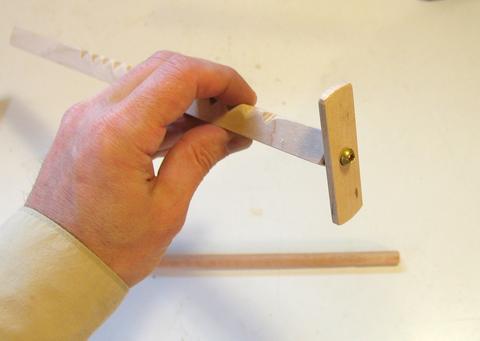 Next we need to make the propeller...
Next we need to make the propeller...
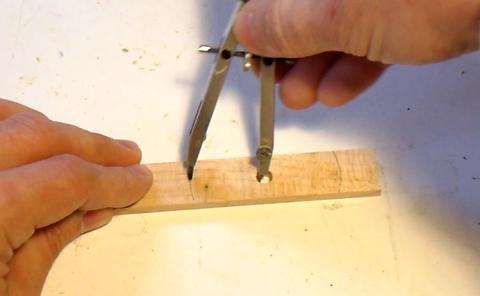 The propeller is made from a piece of wood about 2-3 mm thick.
I drilled a 1/4" (6 mm) hole in it.
Next, I used a compass to mark the outline of the propeller, and then cut that out
with a bandsaw. This way, I can be sure that the hole is in the middle.
The propeller is made from a piece of wood about 2-3 mm thick.
I drilled a 1/4" (6 mm) hole in it.
Next, I used a compass to mark the outline of the propeller, and then cut that out
with a bandsaw. This way, I can be sure that the hole is in the middle.
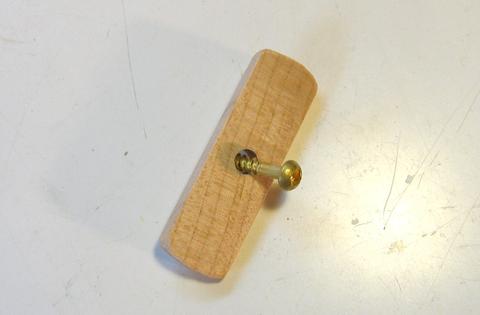 The propeller fits very loosely over a screw or nail. The hole is sized to give
maximum play without the propeller falling off the screw.
It's a combination of the looseness of the propeller over the screw (or nail)
and the vibrations that actually makes it spin.
The propeller fits very loosely over a screw or nail. The hole is sized to give
maximum play without the propeller falling off the screw.
It's a combination of the looseness of the propeller over the screw (or nail)
and the vibrations that actually makes it spin.
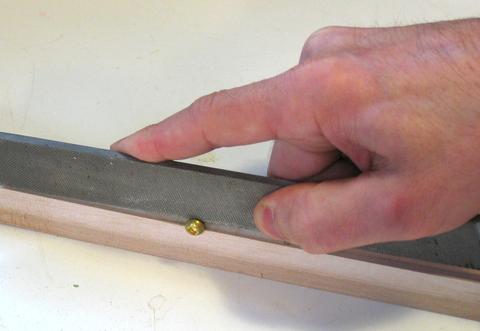 It helps to roughen the shank of the screw a little bit to help drive the propeller.
I'm pressing a file firmly down on the shank and rolling it back and forth
to knurl it.
It helps to roughen the shank of the screw a little bit to help drive the propeller.
I'm pressing a file firmly down on the shank and rolling it back and forth
to knurl it.
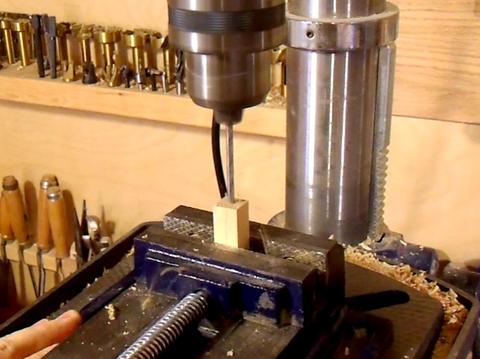 Next, drilling a hole in the end of the stick. The hole is sized just a tiny bit larger
than the major diameter of the threads. Otherwise, there's risk of splitting the stick. If the
screw ends up too loose, you can always fill the hole with glue before you put the screw in.
Next, drilling a hole in the end of the stick. The hole is sized just a tiny bit larger
than the major diameter of the threads. Otherwise, there's risk of splitting the stick. If the
screw ends up too loose, you can always fill the hole with glue before you put the screw in.
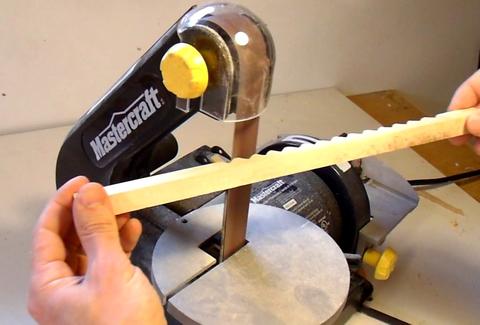 Your fingers end up touching the edges of the notches when operating the hui, so it's
best to smooth those out a bit. I'm using my strip sander, touching
the hui against the part where the belt doesn't have any backing.
Hand sanding would work too, but I bought this strip sander absurdly
cheap just recently, so it's fun to find new uses for it.
Your fingers end up touching the edges of the notches when operating the hui, so it's
best to smooth those out a bit. I'm using my strip sander, touching
the hui against the part where the belt doesn't have any backing.
Hand sanding would work too, but I bought this strip sander absurdly
cheap just recently, so it's fun to find new uses for it.
Also sand the corners at the ends of the stick. That will make it more comfortable to hold at the back and allow the propeller turn more easily at the front.
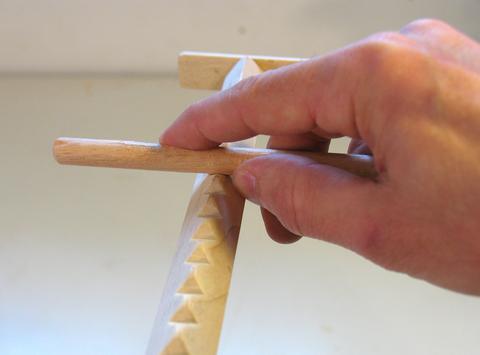 The key to making the propeller turn is how you hold the dowel as you rub it across the notches.
The dowel needs to be firmly held. As you rub the dowel back and forth, press your thumbnail
against the slanted side of the stick. It's the pressing of the thumbnail that alters
the vibrations in the stick. It's the asymmetric nature of the vibration that gives the
propeller it's kick. This handhold will make the propeller turn counterclockwise.
The key to making the propeller turn is how you hold the dowel as you rub it across the notches.
The dowel needs to be firmly held. As you rub the dowel back and forth, press your thumbnail
against the slanted side of the stick. It's the pressing of the thumbnail that alters
the vibrations in the stick. It's the asymmetric nature of the vibration that gives the
propeller it's kick. This handhold will make the propeller turn counterclockwise.
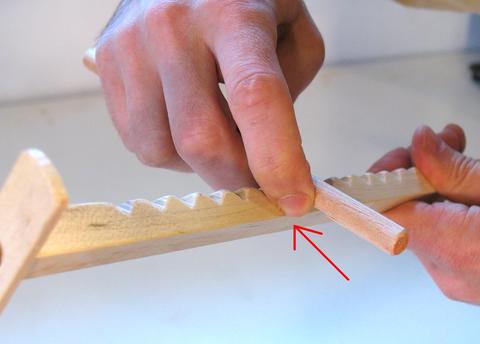 To make the propeller turn clockwise, you need to press a finger onto the other side
of the stick. With the index finger reaching over the stick, press the side of
it against the stick. Ideally, you'll be pressing the side of the finger nail against
the stick.
To make the propeller turn clockwise, you need to press a finger onto the other side
of the stick. With the index finger reaching over the stick, press the side of
it against the stick. Ideally, you'll be pressing the side of the finger nail against
the stick.
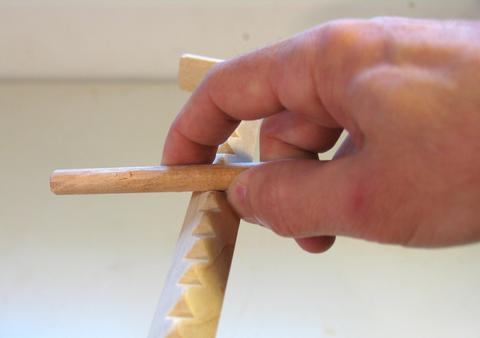 The key to not giving away the trick is to always have both fingers in place and to press
the stick against one finger or the other. If you keep your fingers close enough all the time,
it's really hard to tell that you are pressing with one finger or the other. That makes
the whole thing look like magic!
The key to not giving away the trick is to always have both fingers in place and to press
the stick against one finger or the other. If you keep your fingers close enough all the time,
it's really hard to tell that you are pressing with one finger or the other. That makes
the whole thing look like magic!
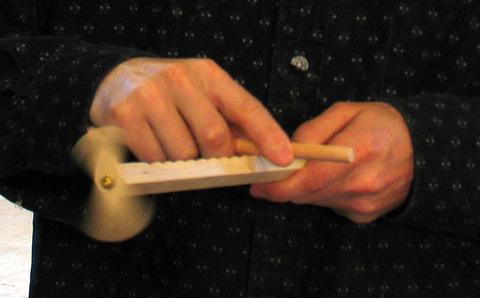 When I took video of this hui, I was able to get the propeller to spin fast enough that it appeared
to stand still. With my camera shooting 30 frames per second, that means the propeller was
turning at 15 turns per second, or about 900 RPM.
When I took video of this hui, I was able to get the propeller to spin fast enough that it appeared
to stand still. With my camera shooting 30 frames per second, that means the propeller was
turning at 15 turns per second, or about 900 RPM.
Stevin Ramsey has recently done a video on building one of these, although he wasn't able to get his going nearly as fast. He should have made a bigger hole in the propeller!
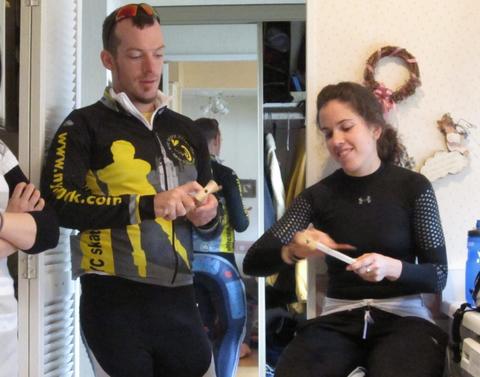 I recently make two of these for my nephews for Easter, but, as it turned out,
the adults were much more fascinated by it than the kids.
In retrospect, I guess it only makes sense. To a four year old, the whole world is
full of magic, so a little propeller that spins when you rub two sticks
together doesn't seem very special. But to adults who profess to understand
the world around them, that little bit of "magic" is fascinating.
I recently make two of these for my nephews for Easter, but, as it turned out,
the adults were much more fascinated by it than the kids.
In retrospect, I guess it only makes sense. To a four year old, the whole world is
full of magic, so a little propeller that spins when you rub two sticks
together doesn't seem very special. But to adults who profess to understand
the world around them, that little bit of "magic" is fascinating.
If you are wondering about the outfits these two in this picture are wearing, see here.